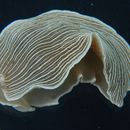Look Alikes
(
İngilizce
)
Invertebrates of the Salish Sea tarafından sağlandı
How to Distinguish from Similar Species: This species is very distinctive. No other local species has the combination of the anus on the right side, longitudinal white ridges on the dorsum, and no cerata.
- lisans
- cc-by-nc-sa
- telif hakkı
- Rosario Beach Marine Laboratory
Habitat
(
İngilizce
)
Invertebrates of the Salish Sea tarafından sağlandı
Sandy bottoms
- lisans
- cc-by-nc-sa
- telif hakkı
- Rosario Beach Marine Laboratory
Distribution
(
İngilizce
)
Invertebrates of the Salish Sea tarafından sağlandı
Geographical Range: Gulf of Alaska to Panama
- lisans
- cc-by-nc-sa
- telif hakkı
- Rosario Beach Marine Laboratory
Habitat
(
İngilizce
)
Invertebrates of the Salish Sea tarafından sağlandı
Depth Range: Mostly subtidal, 1 to 230 m
- lisans
- cc-by-nc-sa
- telif hakkı
- Rosario Beach Marine Laboratory
Comprehensive Description
(
İngilizce
)
Invertebrates of the Salish Sea tarafından sağlandı
This nudibranch has white longitudinal ridges on a brownish background. It has a white or cream line outlining the edge of the dorsum. Its anus is on the right side of the body, on a papilla in a groove between the dorsum and the foot. The gills are also located in this groove. It has no dorsal outgrowths except for the rhinophores. The rhinophores have longitudinal grooves in the clavus and project anteriorly out of a notch at the front of the mantle. Length to 7 cm.
- lisans
- cc-by-nc-sa
- telif hakkı
- Rosario Beach Marine Laboratory
Comprehensive Description
(
İngilizce
)
Invertebrates of the Salish Sea tarafından sağlandı
Biology/Natural History: This species eats sea pens such as Ptilosarcus gurneyi.. May be largely buried in the sand with primarily the rhinophores projecting above the surface of the sand. Eggs are laid in a pale pinkish-brown spiral chain of capsules. According to Baltzley et al.,, many gastropods, including this species, have a special network of pedal ganglia in their foot which assists in crawling. The two main neurons involved produce pedal peptides which elicit an increase in the rate of beating of cilia on the foot, resulting in crawling.
- lisans
- cc-by-nc-sa
- telif hakkı
- Rosario Beach Marine Laboratory

